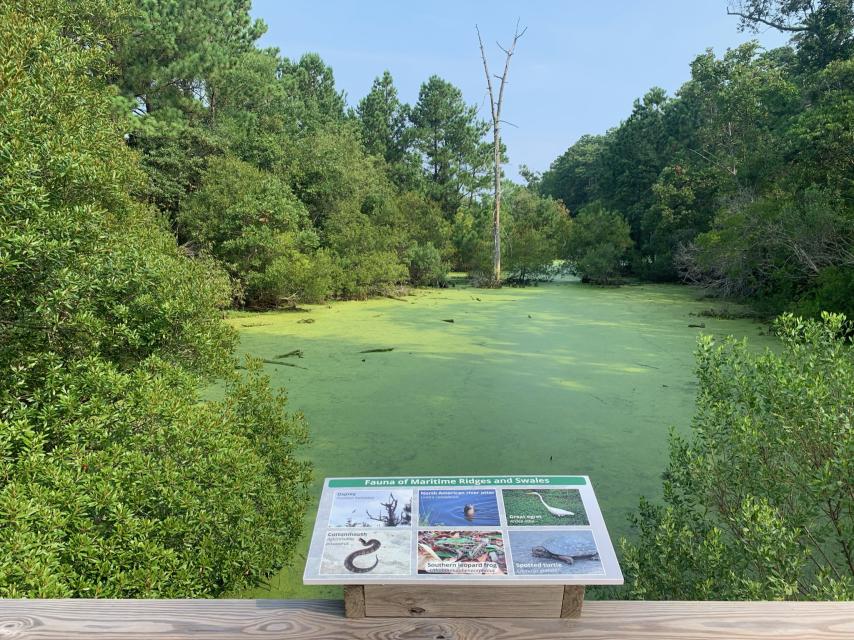Buxton Woods Reserve

Natural Features
The 1,007-acre Buxton Woods component of the N.C. Coastal Reserve is located on Hatteras Island in the Southern Outer Banks. Much of the property is bordered by the Cape Hatteras National Seashore. This site is also a Dedicated Nature Preserve, authorized by G.S. 143B-135.250.
The site is located within the largest remaining contiguous tract of Maritime Evergreen Forest on the Atlantic coast. The Reserve also contains the only occurrence of maritime shrub swamp (dogwood subtype) community in the world. Buxton Woods is a major source of groundwater recharge for Hatteras Island, and the western part of the reserve partially surrounds the county’s well field.
Buxton Woods occurs on a series of east-west running relic sand dunes. The seaward (southern) edge of the forest is a shrub thicket community dominated by live oak and red cedar. Further inland, the dune ridges are stabilized by a maritime evergreen forest. Visitors will be struck by the elevation and beautiful views from these ridges. A good example of a remnant dune ridge can be found on the “Lookout Loop” trail off Old Doctor’s Road. Between the ridges, broad depressions support both seasonally and permanently flooded freshwater marshes, called “sedges.”
The mix of Labrador and Gulf Stream currents off the coast of Cape Hatteras support a rich diversity of subtropical and temperate species. Buxton Woods is the northernmost maritime forest that contains abundant dwarf palmetto (Sabal minor), giving the forests a different feeling than the more northerly maritime forests in the Outer Banks where sweetgum (Liquidambar styraciflua) and red maple (Acer rubrum) are more abundant. The golden silk orbweaver (Nephila clavipes), uncommon in the northern Outer Banks, are commonly seen here in the summer.
Buxton Woods serves as an important resting place for migratory birds in the fall. More than 360 species of birds, including bald eagles and peregrine falcons, have been recorded. Common mammals are gray fox, mink, river otter, and white-tailed deer. Reptiles and amphibians found here include eastern box turtles, green anoles, and southern dusky salamanders. Two rare butterflies (northern hairstreak and giant swallowtail) and a moth (Messalina underwing) are also found in the area.
Visiting the site
Stay safe when visiting! Check out our safety tips here.
You can download a site brochure with a map of Buxton Woods. To access Hatteras Island from the north, visitors can drive south on Highway 12 to Buxton. To access Hatteras Island from the south, visitors can take the public ferry from Ocracoke Island or Cedar Island.
Parking areas for access to hiking trails in the Reserve can be found off Hwy. 12 on Water Association Road. Another access road is Old Doctor’s Road, but please be aware that this road is unpaved and sandy. If you do not have a 4x4 vehicle, do not drive down Old Doctor’s road, but instead park at the kiosk located just off Hwy 12 and walk into the Reserve, or choose another trail access point. The Reserve can also be accessed from hiking trails that connect to trails in the National Seashore. Please note that trails passing through sedges may be wet and/or inaccessible during high rainfall periods.
Note: Water Association Road IS a public road. Visitors to Buxton Woods Reserve are authorized users of this road.
Visitor should be aware that Buxton Woods Coastal Reserve is part of the N.C. Game Lands program, so hunting is allowed at the reserve seasonally. Regulations and details about hunting seasons can be found on the NC Wildlife Resourcse Commission's website. Hunters should review the Buxton Woods game land boundaries before visiting the site to identify where hunting is allowed.
Be a responsible visitor: check out the reserve rules and policies before your visit.
